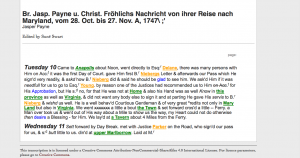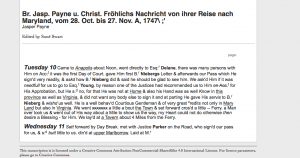In the last month, we have come a long way with our analysis of Payne’s travel journal. We have gone from looking at very distant analyses of the text online to reading the text at a much closer distance that allowed us to create our own databases of the text. We started by marking up our transcriptions on Juxta Editions with the very basic categories such as people, places, and dates. This was done with a few clicks of the mouse in Juxta.
After this we moved on to <oXygen/> XML, which we used to mark the text up with more intricate tags. We downloaded our transcriptions from Juxta and imported them into <oXygen/>. Immediately, the tags we added in Juxta showed up in <oXygen/> and we started to add tags for objects, emotions, misspellings, role names, events, and references to Jesus. As Elena Pierazzo states in her article, “we need to rethink the reasons why we make our transcriptions.” We thought very deeply about what kind of words to tag.
For us it was important to tag dates, events, and places because it is a journal that we transcribing and we want to keep track of a journey. Sometimes we had to face even tougher decisions than just whether or not to tag a word. For example, it required some more thinking to determine whether a word was a place vs an object. We had to just all agree on the same tag so we could be as consistent as possible. It was important to tag people and role names, because we want to keep track of all of the characters in our text. Tagging emotions and references to Jesus was very important since the journal was written with an exceptional amount of emotion and most of it because of the writer’s strong religious beliefs. We also tagged misspellings since there are a lot of them, because this edition was written during a time period when people phonetically spelled out words when they wrote them down.
Marking up our transcriptions helped us understand some of the deeper meanings of some words according to the Moravians, especially when religious references were made. It also helped us realize that most of what tagging is is making informed decisions almost every time a new kind of word comes up. Most of our decisions followed Pierazzo’s five parameters of decision making, including (1) the purpose of the edition, (2) the needs of the readers, (3) the nature of the edition, (4) the capabilities of the publishing technology, and (5) the amount of time available for the job. Parameters (1)-(3) required more thinking every time we came across a word. Whereas, parameters (4) and (5) were more automatic and required little to no thinking. The first three parameters helped us to know “where to stop,” as Pierazzo writes. In other words, it helped us not only to know which words to tag, but, just as importantly, it helped us to know which words NOT to tag.
After tagging the transcription, we made a prosopography of our people and places. We could organize that data any way we wanted. Then we added a CSS file that was linked to our transcribed pages. With this file we could edit the way the files would be displayed online. We could format the fonts by tag, for example we could make all names of people appear in a green, italicized font if we wanted to. This required more thinking and decision-making. At first, I changed the colors of every different kind of tag and changed the fonts until the text actually became to distracting to read. So, I took a step back and thought more deeply about what the reader should get out of reading my edited transcription. I chose to enlarge and bold the dates, underline place names, and bold person names, because this is important information for the journey. I also chose to italicize misspelled words so the reader will not be confused or to show how the language has changed over time. Here is a before and after of my edited file:


Doing this helped me understand how edited texts were produced and how distant reading can be done on texts using this. this made me realize that we could start by closely reading a text and collecting and organizing all of its data, which will then help others to distantly read our text.
Leave a Reply